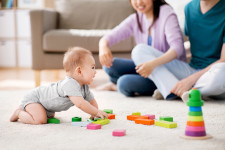Playtime with your baby: Learning and growing in the first year
You are your baby’s first playmate. Play is a fun way for the two of you to bond. It also encourages healthy child development.
Play is how children learn—about themselves, other people, and the world around them. It helps to build confidence, relationships, and basic skills.
Toys for babies don’t need to be expensive. They can be things you have around the house, as long as they are unbreakable, safe (no loose parts, broken pieces or sharp edges), and the right size (anything that can fit through a paper towel roll is too small). Good toys are washable, and made to last.
Words and music: Instant playtime
For the first year of your baby’s life, play won’t involve many toys. Reading, speaking, and singing are fun, easy and portable ways to play with your baby. And they are rich learning experiences. Here are some suggestions:
- Use rhymes, games and songs as you go through the routines of your day. You can make up a diaper-changing tune, or try a little rhyme as you’re putting the snowsuit on.
- Play with books. Read with your baby every day, and remember that babies also want to play with books. They like to put books in their mouth and try to turn pages, so provide clean and sturdy board books.
- Encourage babble. It’s how babies learn to make sounds with their own voices. Repeat these sounds, and turn them into real words. You’ll help your baby recognize which sounds form language.
From birth to 3 months
Your newborn baby is developing hand-eye coordination. Reaching for and touching things, and learning how to hold them provides wonderful stimulation. Good playthings for this age include:
- Cloths or transparent scarves that can be used for peek-a-boo
- An unbreakable mirror placed so that baby can see themselves
- Fabric “bracelets” (soft rattles that can attach to your baby’s wrists or ankles)
- Pieces of brightly coloured cloth with different textures
- Anything with a face on it—dolls, pictures, stuffed animals
From 3 to 6 months
At this age, your baby is developing both fine motor (using hands and fingers) and gross motor (moving arms and legs) skills. They are fascinated with their own hands, and starting to connect how arm and hand movements feel with their desire to make them happen. Toys that can help support your baby’s development include:
- Sturdy rattles
- Peek-a-boo scarves
- Doughnut-shaped objects made from plastic or fabric, large enough to grasp
- Pieces of brightly coloured and textured fabric (terry cloth, silk, fake fur)
- A play arch where baby can lie on their back and bat or kick at toys hanging above
- Toys that make interesting sounds (rattles, shakers, chimes) are better than toys that make electronic sounds. Just be sure they are not too loud for the baby’s sensitive ears.
From 6 to 12 months
In the second half of the first year, your baby sees anything within reach as a potential toy. And if they can reach it, they will probably put it in their mouth. Your baby wants to know how things work, and what they do when they are dropped, rolled, shaken, banged or thrown. Toys that are safe and appealing to babies this age include:
- Stacking and nesting toys: A set of nesting cups and some sturdy blocks are a great investment. They’ll provide hours of playtime well beyond your baby’s first year.
- Cups, little pails and other unbreakable containers
- Large building blocks
- Board books
- A soft ball, as long as it is too big to fit in a baby’s mouth. Avoid balls with a plug/pin that could be a choking hazard if it comes out.
- Shape sorters
- Trucks, cars
- Riding toys designed for babies this age
- Soft toys small enough to handle
- Percussion instruments: shakers, a small drum, or a “rain maker.” You can also make these from containers and fillers you have at home (for instance, put lentils or dry beans in a water bottle and secure the top tightly with some tape).
- Toys that encourage “visual tracking” (following a moving object with your eyes), like a ball ramp, or a push-and-go rolling toy.
- Bath toys, like boats to float and cups for pouring. Make sure they are cleaned and dried regularly.
Safety tip: Always check the label to make sure the toy is right for your baby’s age.
Active play
Active play starts from birth. Very young babies need “tummy time” each day (while they are awake) to help strengthen the muscles in their neck and upper body.
As you encourage your 6-month-old to reach for objects or try new things, you are encouraging active play. When they start to crawl, they will need lots of supervised floor time to explore.
Make sure your baby doesn’t spend long periods of time in a seat, high chair or stroller. Avoid screens and other electronic media. Babies learn best by engaging with loving caregivers.
Reviewed by the following CPS committees
- Public Education Advisory Committee
Last updated: July 2022

